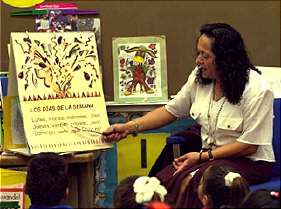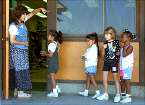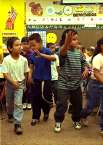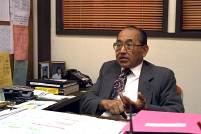A VISIT TO A BILINGUAL FIRST-GRADE CLASS

Teachers at Foothill Elementary school help Spanish
speaking children learn academic skills and make the
transition to classes taught in English.
(Story and photos by Kerry Richardson)

In September, 1995, I spent part of two days visiting two first-grade
classrooms that are part of the bilingual education program at Foothill
Elementary School in Pittsburg, California. This school year, teachers of
the two classes are trying a team approach.
Eva Cordova Steffani instructed her class using the Spanish language.
Newly enrolling students were placed with her following an evaluation of
their ability to speak and understand English. Steffani is a 21-year
veteran bilingual teacher. She says that children who enter the bilingual
program in kindergarten speaking no English might start reading in English
by second grade, and move into a regular classroom for third or fourth
grade.

Students with better English language skills were in the class in the next
room taught in English by Traci Quesada Wieland. Also, half of Wieland's
class are native English speakers. Wieland was born and raised in nearby
Antioch, California, and she recalls that her grandmother spoke only
Spanish. Her mother is an aide at Foothill school where Wieland herself
was an aide until becoming a credentialed teacher through a minority
recruitment program.
On Monday morning, Wieland walked with her class to the school library.
They spent about 25 minutes there, while students found and checked out
books and read at tables. The librarian explained that you must return the
library book you have before checking out a new book.

In addition to English titles such as "Old Hat, New Hat," the library has
Spanish language titles such as "Los Animales," and "El Clima y Sus
Cambios," a book about changes in climate. Student Lupe Gallegos looked
at a Spanish language book at the library. Later back at the classroom, he
showed me an English language book he had obtained from his Sunday
School class.
Classroom activities in Traci Quesada Wieland's class included a class
meeting where students sat in a circle and took turns complimenting and
thanking each other. The school district has implemented a life skills
program emphasizing guidelines such as "doing your best," and "no
putdowns." Friendship is considered important.

For their writing assignment the children wrote about one of their
classmates, Alexis, who wore a paper crown, having been designated for
special attention that day as class queen. On student noted that if you
write "Alexis is," the letter "s" is used two times. During class, a parent
brought in an alligator puppet that was then used in a sing along. During a
show and tell period one girl shared a photo of her father in his police
uniform.
At times, some of the students would move to the other classroom for a
lesson. Wieland likes working in conjunction with Steffani, and thinks it
is good for the children also. "They have two teachers who really really
care for them they can go to at any time," she said. At the end of the day
as the children left her class, Wieland shook hands and spoke with each
student.
On Tuesday morning I observed Eva Cordova Steffani's class being taught
in Spanish. Reading and arithmetic were interwoven with singing and a
dance break to music from a recording Steffani had found on a vacation in
Mexico. Steffani reviewed the days of the week, and the students worked
with the number eight. She demonstrated pronunciation including the
sound represented by the letter "p" in the word "puma."

Her lesson plan included a sequence about "Papa Manzano" who is known in
English as Johnny Appleseed. Steffani showed illustrations of
Manzano/Appleseed while explaining the story of the man who travelled
from place to place planting the seeds of apples. The students then did
craft work involving cutting and pasting paper cutouts of Papa Manzano
and apples. After class Steffani explained to me a sympathetic aspect
about Johnny Appleseed's character. "He had nothing but he gave of
himself," she said.

Steffani believes in her work with the Spanish-speaking children. "In an
all-English classroom, they clam up," she said. As for placing children in
a classroom where they don't understand the language, she said, "It's
cruel!" Steffani explained that some of her students have recently moved
to Pittsburg from Mexico, and the culture and environment here are totally
new to them, they don't have the same backgrounds as their Anglo
counterparts. Steffani is proud of her work. "My kids are happy here," she
said.
I visited Foothill Elementary principal Lee Arevalo in his office. He noted
that the school district had a growing minority population and many
students have parents who speak only Spanish. "We have to come and meet
the needs of those students," he said. Arevalo admitted some concern
about the current criticism by politicians of bilingual education, but noted
that, so far, the program had been able to find funding to continue hiring
teacher's aides.

Also, Arevalo had been thinking that, in addition to teaching English to
Spanish speaking children, it would be good to offer Spanish to English
speakers. "I feel like we're moving in the direction of asking the parents
if we can have instruction in Spanish before or after school," he said. "To
me, it seems like we've got to do something about how our youngsters
grow up feeling about each other as a group. We're not together.
Something needs to happen," he said.
Later in the week there was sad news for the teachers and students at
Foothill Elementary. Their principal, Lee Arevalo, passed away after
suffering a stroke.







